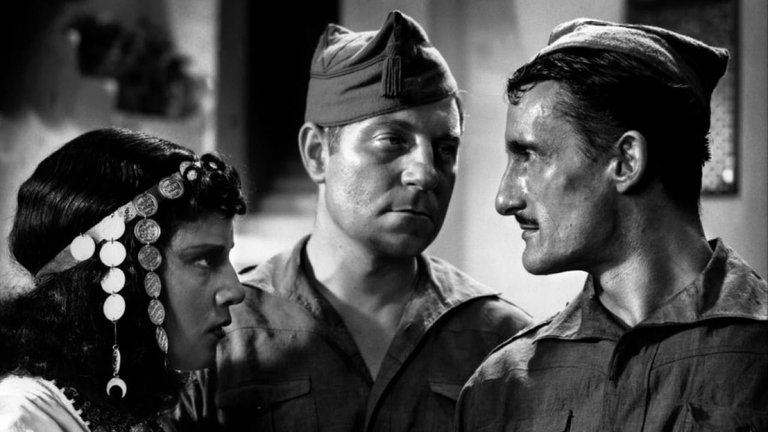Film Review: La Bandera (1935)

Second Spanish Republic was short-lived and today it is mostly known for the brutal war that led to its demise and replacement with Franco’s dictatorship. Small glimpse of it during peacetime is provided by La Bandera, 1935 drama directed by Julien Duvivier, one of the biggest hits of 1930s French cinema.
The film is based on the eponymous novel by Pierre Mac Orlan. The plot begins one night in Paris where the drunk couple stumbles on the man who apparently committed a bloody murder. That man is Pierre Gillieth (played by Jean Gabin), the protagonist. He escapes across the border and ends in Barcelona where he is soon left penniless and hungry. The only way out is provided by Spanish Foreign Legion, which, like its more famous French counterpart, doesn’t ask its recruits anything about their past and allow them to start their lives from scratch. In exchange, legionnaires are obligated to serve Spain in rather unattractive garrisons in Spanish Morrocco where they must endure intense heat, harsh discipline and occasional skirmishes with native rebels. Gillieth is a strong man who can take it, but it is another matter with fellow legionnaire Fernando Lucas (played by Robert Le Vigan) who, unlike his peers, apparently clings to his past. Two men dislike each other and their conflict slowly escalates while, at the same time, Gillieth during visits to local “house of ill repute” meets beautiful dancer Aischa la Slaoui (played by Annabella). He falls in love and marries her, but plans for their future together, as well as conflict with Lucas, become less important when Gillieth’s unit, commanded by Captain Weller (played by Pierre Renoir) gets sent to suicidal mission of holding an important but isolated outpost deep in mountains, surrounded by enemy.
La Bandera was big hit and this could explain by providing many things audience in 1930s loved – dashing antihero as protagonist, exotic settings, melodrama and even some military action at the end. This combination worked as intended, but it probably it wouldn’t work for today’s audience, accustomed to much better deliveries of the same formula. The reason can be found in Julien Duvivier, despite occasionally brilliant scene (like the opening in Paris), failing to bring all those ingredients in the most efficient ways. Early in the film Barcelona is portrayed in nearly documentary style but the effect is at times compromised when protagonist appears in front of obvious rear projection. Some elements of Duvivier’s style look like they were part of Poetic Realism, French film movement that was often seen as predecessor and inspiration for Film Noir in Hollywood, but those scenes all but disappear when plot takes place in Africa. Romantic subplot involving protagonist seems like an unnecessary distraction and Jean Gabin lacks chemistry with Annabella, the biggest French female star at the time, who here looks rather unconvincing as Moroccan woman under heavy makeup. The emotional finale, in which main characters meet their fate at isolated mountain outpost, looks like it was borrowed from Western and appears to be an attempt to wrap up otherwise realistic story according to melodramatic conventions of the period. And it happens a little bit too abruptly, probably due to unwritten rule that feature films at the time must be under hour and half of running time. Jean Gabin is very good in the film, but his performance, as well as the film itself, can be best seen as dry run for future triumphs like Pépé le Moko and Le Quai des brumes.
La Bandera is, despite its flaws, hardly waste of time, at least for cinephiles interested in the period. The film gives plenty of examples how European cinema was at that time, as it is now, relatively more relaxed than Hollywood, which in 1930s suffered under drastic censorship of MPAA Production Code. Apart from openly showing soldiers visiting prostitutes and having tattoos, film in the early scene in Barcelona bar also shows drag queens and dancers in topless, something that would have been unimaginable in mainstream American film for next three decades. Those interested in more general history might also get insight in Spanish Foreign Legion, which was one of country’s more elite units, in scenes that depict their every day life, customs, weapons, uniforms and equipment. Duvivier actually shot films on authentic locations and real Legion provided logistic and material aid to the production thanks to its commander General Franco, to whom the film was originally dedicated. Less than a year, Franco would use Legion in coup that would escalate in civil war and Duvivier would be forced to remove dedication in order not to embarrass himself in front of his mainly left-wing colleagues that supported Spanish Republic.
RATING: 5/10 (++)
Blog in Croatian https://draxblog.com
Blog in English https://draxreview.wordpress.com/
Leofinance blog https://leofinance.io/@drax.leo
Cent profile https://beta.cent.co/@drax
Minds profile https://www.minds.com/drax_rp_nc
Uptrennd profile https://www.uptrennd.com/user/MTYzNA
Unstoppable Domains: https://unstoppabledomains.com/?ref=3fc23fc42c1b417
Hiveonboard: https://hiveonboard.com?ref=drax
Bitcoin Lightning HIVE donations: https://v4v.app/v1/lnurlp/qrcode/drax
Rising Star game: https://www.risingstargame.com?referrer=drax
1Inch: https://1inch.exchange/#/r/0x83823d8CCB74F828148258BB4457642124b1328e
BTC donations: 1EWxiMiP6iiG9rger3NuUSd6HByaxQWafG
ETH donations: 0xB305F144323b99e6f8b1d66f5D7DE78B498C32A7
